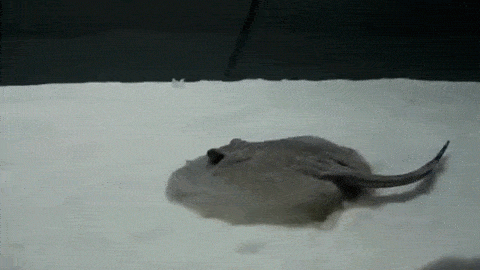With a flurry of motion along its pectoral fin, a sting ray lifts the sand nearby and disappears into the turbid cloud. This tactic helps the animal both hide and escape. In a similar move, sting rays and other bottom-dwelling fish can bury themselves in sand.(Image credit: Y. Coll/OPOTY; via Colossal)
Tag: stingray

“Fade”
Stingrays swim over rippled sands in this award-winning image from photographer Gregory Sherman. Above this peaceful vista, waves break and a dramatic skyscape looms. It’s the regular back-and-forth of the waves that shapes the ripples of sand. The rays can also use the sand for cover; note the remnants of sand atop a few of these rays, and then see how they hide themselves. See more winners from the Underwater Photographer of the Year awards in this gallery. (Image credit: G. Sherman/UPY 2023; via Colossal)

Stingray Eyes
With their flexible, flattened shape, rays are some of the most efficient swimmers in the ocean. But, at first glance, it seems as if their protruding eyes and mouth would interfere with that streamlining. A new study uses computational fluid dynamics to tackle the effects of these protrusions on stingray hydrodynamics.
With their digital stingrays, the team found that the animal’s eyes and mouth created vortices that accelerated flow over the front of the ray and increased the pressure difference across its top and bottom surfaces. The result was better thrust and the ability to cruise at higher speeds. Overall, the ray’s eyes and mouth increased its hydrodynamic efficiency by more than 20.5% and 10.6%, respectively. The lesson here: looks can be deceiving when it comes to hydrodynamics! (Image credit: D. Clode; research credit: Q. Mao et al.)

Hiding in the Sand
Flounders, stingrays, and other flat, bottom-dwelling fish often hide under sand for protection. These fish move by oscillating their fins or the edge of their bodies. They use a similar mechanism to bury themselves–quickly flapping to resuspend a cloud of particles, then hitting the ground so that the sand settles down to cover them. Researchers have been investigating this process by oscillating rigid and flexible plates and observing the resulting flow. When the flapping motion exceeds a critical velocity, the vortex that forms at the plate’s edge is strong enough to pick up sand particles. Understanding and controlling how and when these vortex motions kick up particles is useful beyond the ocean floor, too. Helicopters are often unable to land safely in sandy environments because of the particles their rotors lift up, and this work could help mitigate that problem. (Image credits: TylersAquariums, source; Richmondreefer, source; A. Sauret, source; research credit: A. Sauret et al.)

Stingray Wakes
This numerical simulation shows a swimming stingray and the vorticity generated by its motion. Stingrays are undulatory swimmers, meaning that the wavelength of their motion is much shorter than their body length. Manta rays, in contrast, move their fins through a wavelength longer than their body length, making them oscillatory swimmers. Observe the difference in this video. To swim faster, stingrays increase the frequency of their undulation, not the amplitude. This is quite common among swimmers because increasing the amplitude also increases projected frontal area, which causes additional drag. Increasing the frequency of motion does not affect the projected area, making it the more efficient locomotive choice. (Video credit: G. Weymouth; additional research credit: E. Blevins; submitted by L. Buss)
Also, FYFD now has a Google+ page for those who prefer to follow along and share that way. – Nicole






